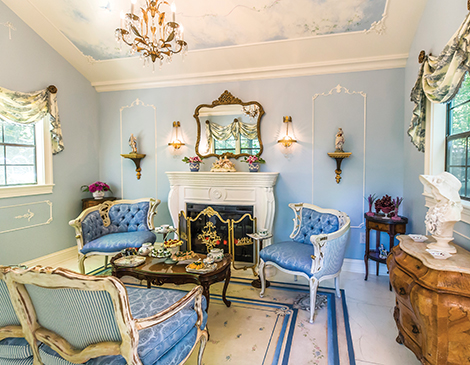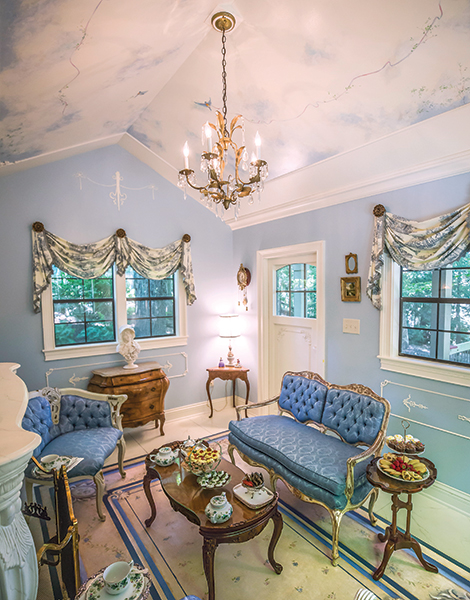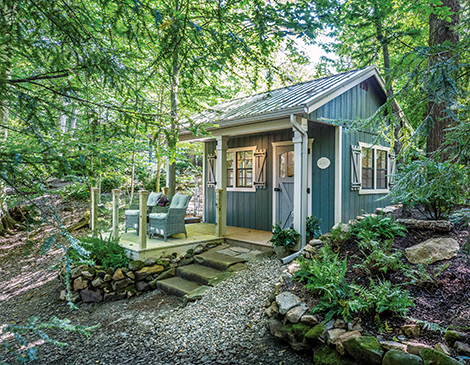It’s a grown-up version of the playhouse little girls dream of, a pretty place with fancy furniture where tea is poured from individual china pots and served with little sandwiches and cakes artfully arranged on silver platters. You’d never know it from the outside. The shell of this Bath Township “she shed” is a 12-by-14-foot prefabricated storage shed, says Susan Lobalzo of Lobalzo Design Associates in Bath.
Her client bought it during the long days of pandemic home confinement, when she was looking to augment the potting shed and lunch pavilion she’d already added along a path that wound through the woods behind her clapboard-sided Cape Cod-style home. “She enjoys having a project, she enjoys entertaining,” Lobalzo says. “This was a new venue for her to do that.”
While the exterior of the blue-gray cedar-sided structure, complete with a front porch, was indeed charming, the inside was unfinished — well-suited for stashing lawn equipment but hardly appropriate for hosting the elaborate afternoon teas the client envisioned. Lobalzo, who taught History of Housing and Furnishings at Kent State University, tells the Cinderella story of turning the humble interior into that of a French Rococo “maisonette.” It stuns first-time guests, in part because the decor, rendered in one of the client’s favorite period styles and beloved blues, is far more opulent than what they’d seen in her comfortably traditional home.

“[The client] gets a real kick out of opening that door and peoples’ jaws dropping when they see what’s inside,” Lobalzo says.
Lobalzo’s first task was making the shed habitable. She hired contractors to put it on a concrete-block foundation, then install insulation, electrical wiring and drywall, along with an electric fireplace to heat the space on cold days when it is in use. Wadsworth artist Paulette Grubb painted the 12-foot-high cathedral ceiling fair-sky blue, complete with puffy white clouds and birds carrying a circular ribbon garland, then faux-finished the wooden fireplace mantle and medium-density fiberboard floor to look like white marble. Her finishing touch: an interxpretation of a blue Aubusson rug, a clear-coated alternative to the real thing that is able to withstand fluctuations in temperature and humidity.
Lobalzo’s biggest challenge was creating the intricate ormolu moldings. She ordered segments of resin reproductions from Chicago-based Decorators Supply Co. to make the designs she’d sketched on paper a reality. “Hours [were] spent looking at the parts and pieces, drawing them to scale to make sure that they were going to fit — and fit appropriately,” she says. Jerry Senn of Senn’s Custom Cabinets in Copley spray-painted the moldings white, then applied them to the baby-blue walls with very fine nails.
“[They’re] not quite as thin as staples, but very close … so that you really don’t have a hole in the molding,” she says. “[The moldings] were also glued from behind to keep them from warping or lifting from the wall.”

Lobalzo dressed the existing windows in blue toile swags and jabots. She furnished the shed with antique and vintage pieces she and her client found in local shops. (Although she had the settee and side chairs reupholstered in dark-blue damask and their white wooden frames touched up, most items simply were “cleaned up.”) They supplemented their finds with a few reproductions, along with furniture and accessories from the client’s home — Lobalzo singles out the Wedgewood cachepots on the mantle, the figurines on the decorative wall brackets, a marble-
topped burled-wood bombe chest under one window, and a blue-velvet Victorian side chair next to the settee.
The client had a contractor build a little deck in front of the shed that overlooks a manmade stream and waterfall. One amenity the place doesn’t have is plumbing. While the client can fetch water for an electric kettle from the nearby potting shed, she and her guests have to make the short walk to the house to use a bathroom. Lobalzo explains that adding a powder room would require laying a sanitary line through the woods and pumping wastewater up a hill to the house’s septic system. She and her client joke about their next project: “the most elegant outhouse in history.”

TIPS FOR BUYING ANTIQUES
Know the dealer: Developing that relationship is one of the ways Lobalzo avoids ending up with a fake. “If they’re a less-than-scrupulous dealer, they have ways of making things [that are not real] look really good,” she says.
Learn before buying: Searching for furniture? “Know a bit of furniture yourself, the structures,” Lobalzo says. Upholstered pieces made before the invention of the cotton gin, for example, will have seeds in the cushions’ cotton stuffing. And thoroughly examine items. If considering the purchase of, say, a chest, “take the drawers out and see how the drawers are made, see if they’re strong.”
Expect to live with imperfections: “Antiques, you really don’t want to refinish them because it reduces the value,” Lobalzo says. Reupholstering furniture and rewiring lamps and lighting fixtures are her exceptions. “Nothing would horrify me more than something catching on fire because of the faulty wiring,” she says. If reupholstering, refinishing or repairing is needed to make a piece usable, find an expert to do it.
For more updates about Cleveland, sign up for our Cleveland Magazine Daily newsletter, delivered to your inbox six times a week.
Cleveland Magazine is also available in print, publishing 12 times a year with immersive features, helpful guides and beautiful photography and design.




